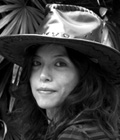
The Connected within the Disconnected | Nagoya Discovered through Design
Is it possible to come up with an appealing proposal for solving Nagoya’s agricultural issues from the urban and architectural perspectives? Year after year, the acreage of deserted agricultural land ten kilometers from the city center has increased. But looking at the Nagoya area as a whole, we can see new possibilities that originate in the compact nature of the city. We’d like to share ideas on developing a feasible, sustainable project that appeals to the citizens, based on a comprehensive understanding of Nagoya agriculture.
Agrink Tour

During our two days of fieldwork, we visited more than ten facilities related to agriculture in Nagoya. We found out that the city is rich in remarkable agricultural elements: the agricultural products that grow in the area, the people and land that produce them and the institutions that offer and publicize them. However, to our surprise, we also found out that the people, places and information related to agriculture are isolated and disconnected from one another.
On the other hand, the compact nature of Nagoya makes it possible to get to agricultural land and facilities within a 30-minute car or train ride from the city’s center.
We recognized the possibility of connecting the disconnected; we propose an agricultural tour based on communication, a device we have termed, “The Agrink Tour”.
By visiting agriculture-related locations within the city, The Agrink Tour will provide participants with the opportunity to think about agriculture. This tour will differ from conventional agricultural tours in that it won’t require traveling great distances, investing great amounts of time or getting close to the soil while attending lectures by agricultural experts. In contrast, the proximity of the Agrink Tour to the concerns of daily life allows participants to experience both the enjoyment of a sightseeing tour and the conception and discovery of unconventional images of Nagoya and its agriculture. On this tour, we won’t only introduce agricultural facilities, but also pinpoint current issues and provide a clue to solving them by addressing possibilities for involving agriculture in the promotion of urban development and solving the problem of successors to agricultural workers.
Included in our proposal is a way for tourists to share and nurture one another’s ideas; we will record them and upload them onto a website, which will eventually lead to the development of more routes as well. One of the distinguishing traits of the Agrink Tour is this accumulation and transmission of bits of creativity that come straight from the tourists. More participation in and enjoyment of the tour, will itself serve as a growing involvement of outsiders in the agricultural sector and will contribute to a diverse vision for Nagoya’s agriculture.
Because of the concentration of both agriculture and creative communication found in this city, the Agrink Tour is poised to become a celebrated Nagoya memento.


MOSAKI : Masaki Onishi
Editor / Architect
Born in 1977 in the Osaka metropolitan area. In 2001, graduated from the Department of Architecture, College of Science and Technology, Nihon University. In 2003, completed a master’s course in Architecture, Graduate School of Science and Technology, Nihon University. After working for Ushida Findlay Architects (UK) in 2003-2004, co-founded MOSAKI. At MOSAKI, Onishi handled editing and design. From 2004 to 2007, he was a tutor in Nihon University’s Department of Architecture. Since 2007, Onishi has served as a committee member in the NU Architecture Forum of Nihon University’s Architecture Department. From 2007 to 2009, he was a member of the Editorial Committee of the Architectural Institute of Japan.

MOSAKI : Motoko Tanaka
Writer / Creative facilitator
Born in Ibaraki Prefecture in 1975. In 1999, chaired the Aoyama Dōjunkai Apartment Building reclamation project DO+. Co-founded MOSAKI in 2004. Primarily involved in writing and direction. In 2007-2008, acted as creative facilitator at co-lab. Since 2009, Tanaka has been a member of the Cultural Affairs Commission of the Architectural Institute of Japan. Among the serializations of Tanaka’s work has been MOSAKI’s Event Pilgrimage (2005-2008: Nikkei Architecture magazine) and Experimental Residential Architecture from the Viewpoint of Wives and Daughters (Mrs. magazine, Bunka Publishing Bureau).

Makoto Tanida
Associate Professor, PhD., Engineering, Department of Architecture, Faculty of Science and Technology, Meijō University
Born in Nagoya, 1971. Graduated from the Department of Architecture, Meijō University in 1995. In 1997, Tanida completed the Master´s course of the Graduate School of Nagoya University, and entered Mitsuru Senda + (Incorporated) Environment Design Institute. In 2003, he withdrew from the doctorate course of the Graduate School of Nagoya University due to the expiration of the term. In 2008, Tanida was an overseas researcher at University of East London. He has participated proactively in initiatives in many interdisciplinary genres, not only architecture: Aichi Arts Downtown Revitalization Project (2007), Tokyo Designers Week (2007), Hiroshima City Museum of Contemporary Art´s Open Call for Art Project Ideas (2009) and Nagoya Design Week (2009, 2010). Tanida, whose concern is on the mutual relationship between human beings and human-built environments, cherishes the moments spent with his students as well as with his family.
Yosuke Akiyama
Graduate School, Nagoya University
Aiko Kuno
Nagoya University of Arts and Sciences
A Lian Lin
Tainan University of Technology
Naoki Morita
Designer
Mikari Tsuka
Nagoya University of Arts
Dan Yan
Nagoya Institute of Technology
